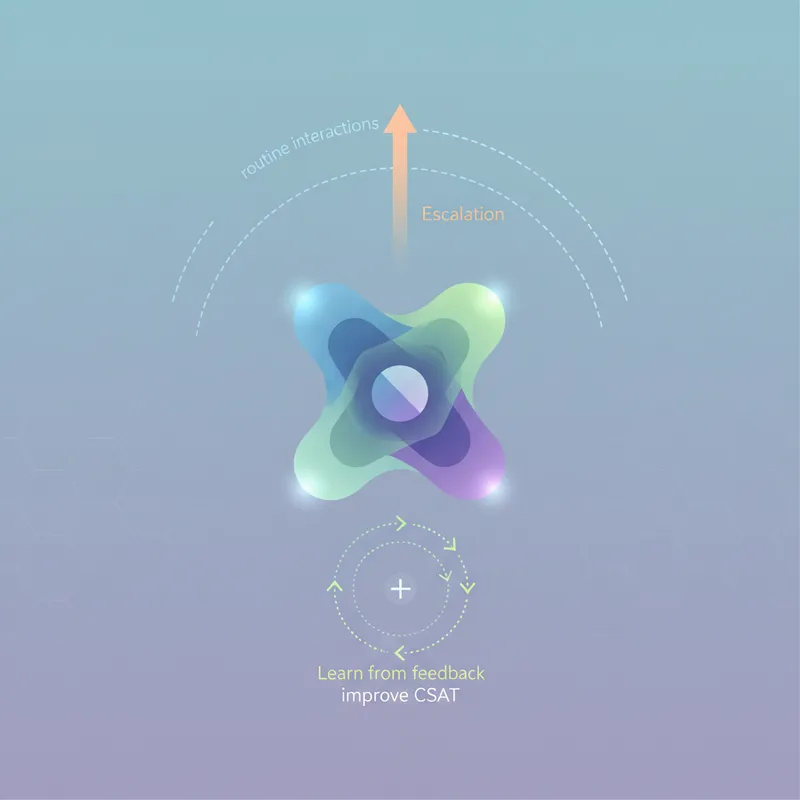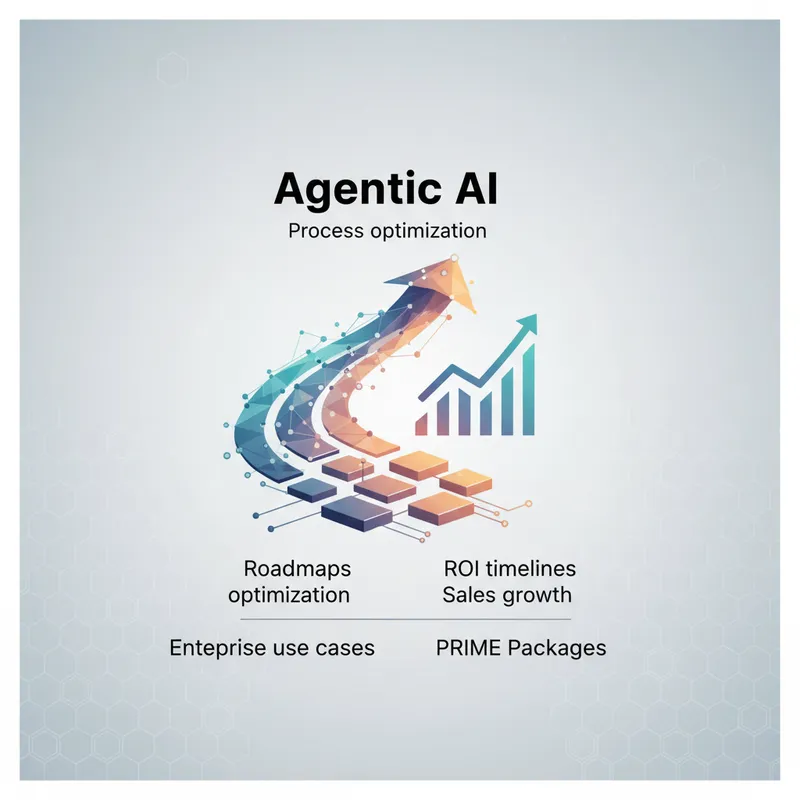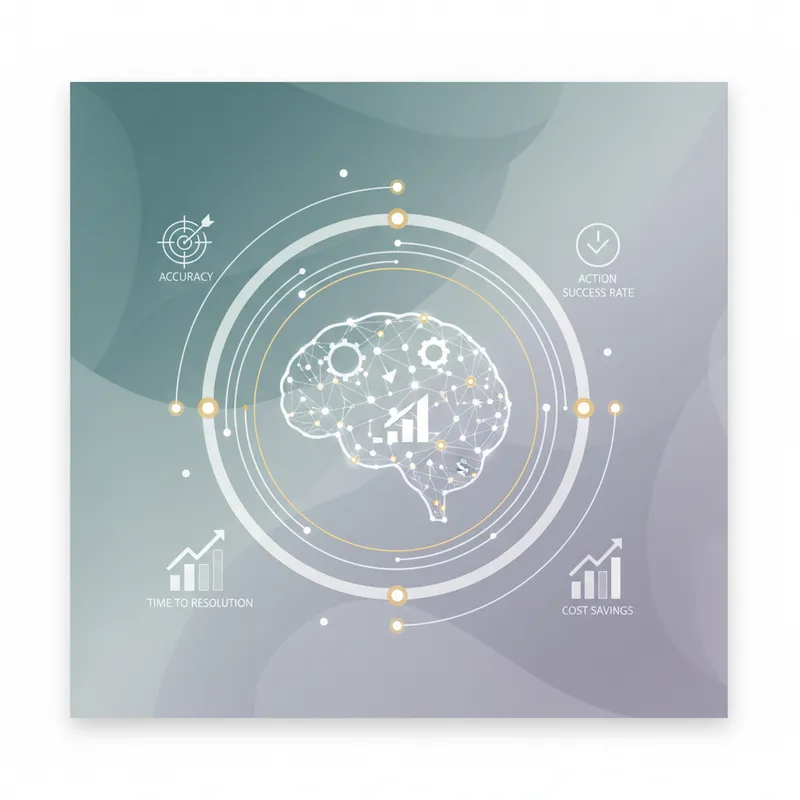
Introduction
Manual, multi-step processes consume time, introduce errors, and slow decision making across teams. This guide explains how to automate workflows with AI using an agentic approach that turns brittle manual flows into resilient, autonomous processes. A.I. PRIME applies a repeatable methodology that maps existing tasks, decomposes them into agentable steps, and layers AI agents that coordinate to execute end-to-end. The result is faster cycle times, fewer handoffs, and predictable outcomes that scale with business needs. Learn more in our post on Training Employees to Collaborate with AI Agents.
In this practical, service-focused guide you will learn the full lifecycle of converting manual processes into agentic AI workflows. We cover discovery, design, agent orchestration, validation, change management, and ongoing governance. You will also find tactical templates, performance metrics to track, and tips to avoid common pitfalls. If you are wondering how to automate workflows with AI in a way that reduces errors and preserves auditability, this post provides the exact sequence that A.I. PRIME uses with clients to deliver resilient automation that aligns with business goals.
Why Agentic AI is the Right Approach for Complex Workflows
Traditional automation approaches often try to bake all logic into a single monolithic process. That creates fragile systems that break when exceptions occur. Agentic AI breaks complexity into autonomous components. Each agent owns a clear responsibility, can use AI to handle uncertainty, and communicates with other agents to achieve a common outcome. This modular structure makes it easier to iterate, debug, and scale. Learn more in our post on CEO Guide: Overcoming the Gen-AI Paradox with Agentic AI.
When evaluating how to automate workflows with AI, consider the benefits of agentic design. Agents can manage retries, escalate to human reviewers when confidence is low, and maintain state across long-running processes. They also enable parallelism so tasks that do not depend on each other can proceed concurrently. This reduces cycle time while preserving traceability and control, which are essential for regulated environments and service-focused implementations.
Agentic AI supports progressive automation. Start by automating high-value, repeatable tasks and let agents handle variations. Over time, agents learn from data and human feedback to improve their confidence and reduce the need for manual intervention. This incremental path answers a frequent question from teams asking how to automate workflows with AI without risking core operations.
A.I. PRIME End-to-End Methodology
A.I. PRIME follows a structured approach to convert manual, multi-step processes into agentic AI workflows. The methodology has seven phases: discovery, process decomposition, agent design, orchestration design, development and integration, validation and pilot, and governance and scale. Each phase has clear deliverables and acceptance criteria to ensure the resulting automation meets business objectives and compliance needs. Learn more in our post on Market Map: Top Agentic AI Platforms and Where A.I. PRIME Fits (August 2025 Update).
Below we walk through each phase in depth and provide practical checklists and templates. This is the sequence you can adapt when you are ready to implement how to automate workflows with AI in a production setting. The emphasis is on reducing cycle time and error rates while preserving full auditability and human-in-the-loop controls where required.
Phase 1: Discovery and Value Mapping
Start by selecting a process with measurable volume and pain points. Conduct stakeholder interviews to gather a process map, exception types, frequency of each branch, and current cycle time. Document KPIs such as end-to-end lead time, human touchpoints, error rate, and compliance risks. These baseline metrics will allow you to quantify improvements after automation.
Define value criteria for prioritization. Typical criteria include high transaction volume, frequent rework, regulatory exposure, and customer impact. Create a concise business case for each candidate process showing estimated time saved and error reduction. This helps secure sponsorship and budget for an agentic AI initiative focused on how to automate workflows with AI across enterprise teams.
Phase 2: Process Decomposition and Agent Boundary Definition
Break the process into discrete steps that can be assigned to independent agents. Use a whiteboard or process modeling tool to identify inputs, outputs, decision points, and exception paths. For each step determine whether it is human-centric, rule-based, or well suited for an AI agent that can interpret context, extract entities, or recommend actions.
Define agent boundaries around coherent responsibilities. A good rule is one agent per decision domain or external system interaction. Clear boundaries minimize cross-agent coupling and make the system more resilient. For example, separate agents might handle document ingestion, data extraction, approval routing, regulatory validation, and final posting.
Phase 3: Agent Design and Capabilities
For each agent, document the required capabilities, inputs, outputs, confidence thresholds, and fallback behaviors. Specify the AI techniques involved such as natural language understanding, document parsing, named entity recognition, or anomaly detection. Also define the guardrails and explainability requirements so each agent can provide justification for its actions.
Design agents to be observable. They should emit events for key decisions including confidence scores and reasoning. Agents must also support human overrides and provide clear context so a reviewer can make fast, informed corrections. Recording these interactions helps agents improve when human feedback is captured as training signals.
Phase 4: Orchestration Design and Communication Patterns
Design the orchestration layer that coordinates agent workflows. The orchestrator manages sequencing, parallel execution, retries, and long-running state. Decide how agents will exchange data, how the orchestrator will handle exceptions, and how to escalate to human reviewers. Use message-based communication for loose coupling and resiliency.
Ensure the orchestrator preserves an audit trail. This includes recording which agents ran, inputs they received, outputs produced, and decision rationale. The audit trail must be queryable for compliance and postmortem analysis. With a solid orchestration design, you can answer complex questions about system behavior during audits or incidents which is essential for teams seeking how to automate workflows with AI responsibly.
Phase 5: Integration and Implementation
Integrate agents with existing systems of record through secure connectors and APIs. Use authentication best practices and ensure data minimization. Implement transformation layers to handle schema mismatches and versioning. Build monitoring endpoints to capture latency, error counts, and throughput for each agent and for the orchestrator as a whole.
During implementation, maintain a test harness that can simulate different process paths and edge cases. Automate regression tests to validate both functional behavior and agent performance metrics like precision and recall. This approach reduces risk when deploying new agent versions and supports continuous improvement as you scale how to automate workflows with AI across additional processes.
Phase 6: Validation, Pilot, and Gradual Rollout
Run pilots with a subset of real cases. Use shadow mode to compare agent decisions against human outcomes without impacting production. Measure key metrics and tune confidence thresholds. Pilot results should be evaluated against baseline KPIs established during discovery. Only graduate to full production when the error rate, cycle time improvements, and stakeholder adoption meet acceptance criteria.
Adopt a progressive rollout strategy. Start with low-risk cases and expand as agent performance stabilizes. Provide clear escalation paths and ensure human reviewers can intervene. Collect structured feedback from reviewers to feed into model retraining and rule adjustments. This human-in-the-loop loop is critical when configuring how to automate workflows with AI while maintaining trust and control.
Phase 7: Governance, Monitoring, and Continuous Improvement
Implement a governance framework that defines roles, responsibilities, and policies for agent updates, model retraining, and exception handling. Establish monitoring dashboards that track both business KPIs and technical health indicators. Schedule regular audits to validate compliance, fairness, and safety of agent decisions.
Continuous improvement comes from closed loop feedback. Capture corrections and escalations as labeled data, prioritize improvements based on impact, and apply A/B testing to measure changes. Over time, agents will require fewer interventions and will unlock more processes for automation, demonstrating the long term value of a disciplined approach to how to automate workflows with AI.
Technical and Organizational Best Practices
Successful automation initiatives combine technical rigor with strong organizational alignment. On the technical side, invest in data quality, secure integrations, and robust observability. On the organizational side, prepare teams for role shifts. Automation often reduces repetitive tasks but increases demand for oversight, exception management, and optimization skills. Provide training and create new career paths that leverage human strengths in judgment and strategy.
Define clear success metrics for pilots and production workloads. Common metrics include cycle time reduction, error rate reduction, percentage of cases fully automated, and human intervention time per case. Align these metrics with business objectives such as cost savings, customer satisfaction, and compliance outcomes. Transparent measurement helps sustain executive sponsorship and prioritizes future automation opportunities when assessing how to automate workflows with AI across the organization.
Security and privacy must be embedded from day one. Implement role based access controls for agents and data stores. Use encryption for data in transit and at rest. Maintain data retention policies and anonymize sensitive data when it is not needed for model training. Demonstrating strong security practices increases stakeholder confidence and reduces deployment friction.
Design Patterns and Templates for Agentic Workflows
Below are common design patterns that simplify agentic workflow construction. These patterns are practical templates you can apply when designing your own agents to learn how to automate workflows with AI more quickly.
- Document Ingestion and Enrichment - An ingestion agent normalizes incoming files, extracts structured fields, and routes documents to downstream validation agents.
- Approval Recommendation - A recommendation agent evaluates criteria and returns a suggested decision plus confidence. A human reviewer finalizes decisions for low confidence cases.
- Normalization and Reconciliation - A reconciliation agent compares records across systems and flags discrepancies for remediation or automated correction with confidence thresholds.
- Exception Triage - A triage agent categorizes exceptions and either routes them to specialized agents or a human queue based on priority and complexity.
Each pattern includes observability hooks and explicit handoff points. When you apply these patterns to real processes, you can accelerate rollout by reusing components and focusing development on unique business logic. This reuse strategy is a powerful lever when expanding how to automate workflows with AI across multiple departments.

Implementation Checklist and Playbook
Use this checklist as a practical playbook for teams asking how to automate workflows with AI. Treat these items as minimal requirements for a responsible and scalable deployment.
- Process selection and baseline KPI measurement completed.
- Process decomposition into agentable steps documented.
- Agent capability matrix with inputs, outputs, and thresholds defined.
- Orchestration design and event schema approved.
- Security and privacy requirements signed off by compliance.
- Test harness with simulated and real case replay available.
- Pilot plan, acceptance criteria, and rollback strategy in place.
- Monitoring dashboards and alerting for errors and performance completed.
- Training plan and change management communication to impacted teams ready.
- Governance policy for model updates and incident response defined.
Following this playbook will reduce rework and help you scale from a pilot to enterprise level automation. The checklist is also useful for vendor evaluations and internal gate reviews when you need to justify how to automate workflows with AI safely and effectively.
Realistic Timelines and Resource Estimates
Timelines vary depending on process complexity and integration needs. A simple, high volume process may reach pilot in 6 to 8 weeks. A complex, cross-system workflow with regulatory constraints often requires 3 to 6 months to move from discovery to production. These estimates include time for stakeholder alignment, integration engineering, model training, and multiple pilot iterations to reach production readiness.
Resource needs typically include a project manager, a solutions architect, one or two AI engineers, integration engineers, and domain subject matter experts. Add support from security and compliance teams for regulated contexts. You will also need access to a test environment and a structured dataset for training and validation. If you are wondering how to automate workflows with AI at scale, plan for a small center of excellence to enable reuse and governance across projects.
Measuring Success and Demonstrating ROI
Quantifying the impact of automation is crucial. Calculate ROI based on reduced human hours, faster throughput, and fewer errors that result in rework or penalties. Translate improvements into monetary terms by estimating hourly costs and error remediation expenses. Track improvements in customer experience metrics such as time to resolution or first touch resolution rate that result from automation.
Key performance indicators to monitor include percent of fully automated cases, average handling time, human intervention time per case, and accuracy or error rate. Use control groups where possible to isolate the impact of automation. Demonstrating measurable gains will secure future investment and support broader adoption of agentic AI strategies that solve how to automate workflows with AI across the business.
Common Pitfalls and How to Avoid Them
Avoid these common pitfalls to ensure a smoother implementation. First, do not over-automate before agents are reliable. Start with semi-automated flows and tune models progressively. Second, do not neglect data quality. Poor training data produces unpredictable agent behavior. Third, avoid ignoring exception paths. Most real world processes have edge cases that must be explicitly handled to prevent failures at scale.
Do not underestimate change management. Employees need clear guidance on new workflows, and champions are critical to accelerate adoption. Finally, ensure you have a rollback and incident response plan. If an agent behaves unexpectedly, you must be able to quickly revert to manual processing and triage the root cause. These precautions will reduce business risk as you learn how to automate workflows with AI responsibly.

Scaling Beyond the First Use Cases
After a successful pilot, scale by cataloging reusable agents and connectors. Maintain a component library so teams can assemble agentic workflows without starting from scratch. Standardize data schemas and event formats to reduce friction across implementations. Encourage internal reuse by publishing playbooks and success stories that describe both technical details and business outcomes.
Consider building a lightweight platform that streamlines agent registration, versioning, and monitoring. This platform reduces operational burden as the number of agents grows and simplifies governance by centralizing metrics, logs, and policy enforcement. With these pieces in place you can broaden the scope of how to automate workflows with AI to cover more business functions and complex, cross functional processes.
Team Structure and Roles for Scale
Create a cross functional team that includes product managers, data scientists, platform engineers, operations, and domain experts. Product managers prioritize opportunities and define acceptance criteria. Data scientists and AI engineers develop and tune agent models. Platform engineers build the orchestration and monitoring infrastructure. Operations manage rollout and incident response. Domain experts provide ongoing validation and label data for retraining when agents evolve.
Formalize a review board to approve production deployments and major agent changes. This board should include security and compliance representatives for regulated workflows. A structured approach to roles and responsibilities accelerates scale and reduces the chance of governance gaps as you expand how to automate workflows with AI across the organization.
Conclusion
Automating multi-step workflows with agentic AI is a practical way to reduce cycle time and minimize errors while preserving control and observability. A.I. PRIME's methodology shows that the key is not just applying AI but designing modular agents, orchestrating them effectively, and embedding governance and human-in-the-loop processes. By following a structured lifecycle from discovery to governance, teams can progressively automate high value processes and deliver measurable ROI.
Start small by choosing processes with clear volume and pain points, then decompose them into agentable steps. Design agents with explicit inputs, outputs, and confidence thresholds. Build an orchestrator that preserves state and audit trails, and run pilots in shadow mode to validate agent performance before full production. Embrace robust testing, data quality, security controls, and transparent monitoring so stakeholders can trust automation outcomes. These practices help you address common concerns about safety and reliability when exploring how to automate workflows with AI.
Human oversight remains important. Effective agentic automation reduces repetitive work and shifts human focus toward exception handling, optimization, and strategy. Invest in training and change management to help staff adapt, and capture their feedback to refine agents and improve models. Over time agents will reduce intervention needs and free teams to deliver higher value outcomes.
Finally, treat automation as a long term capability rather than a one off project. Build a component library, standardize interfaces, and create governance structures that support ongoing improvement. With disciplined practices and a focus on measurable business outcomes you can scale automation across the organization and realize the full potential of agentic AI. This is how to automate workflows with AI in a way that is resilient, auditable, and aligned to business priorities.




